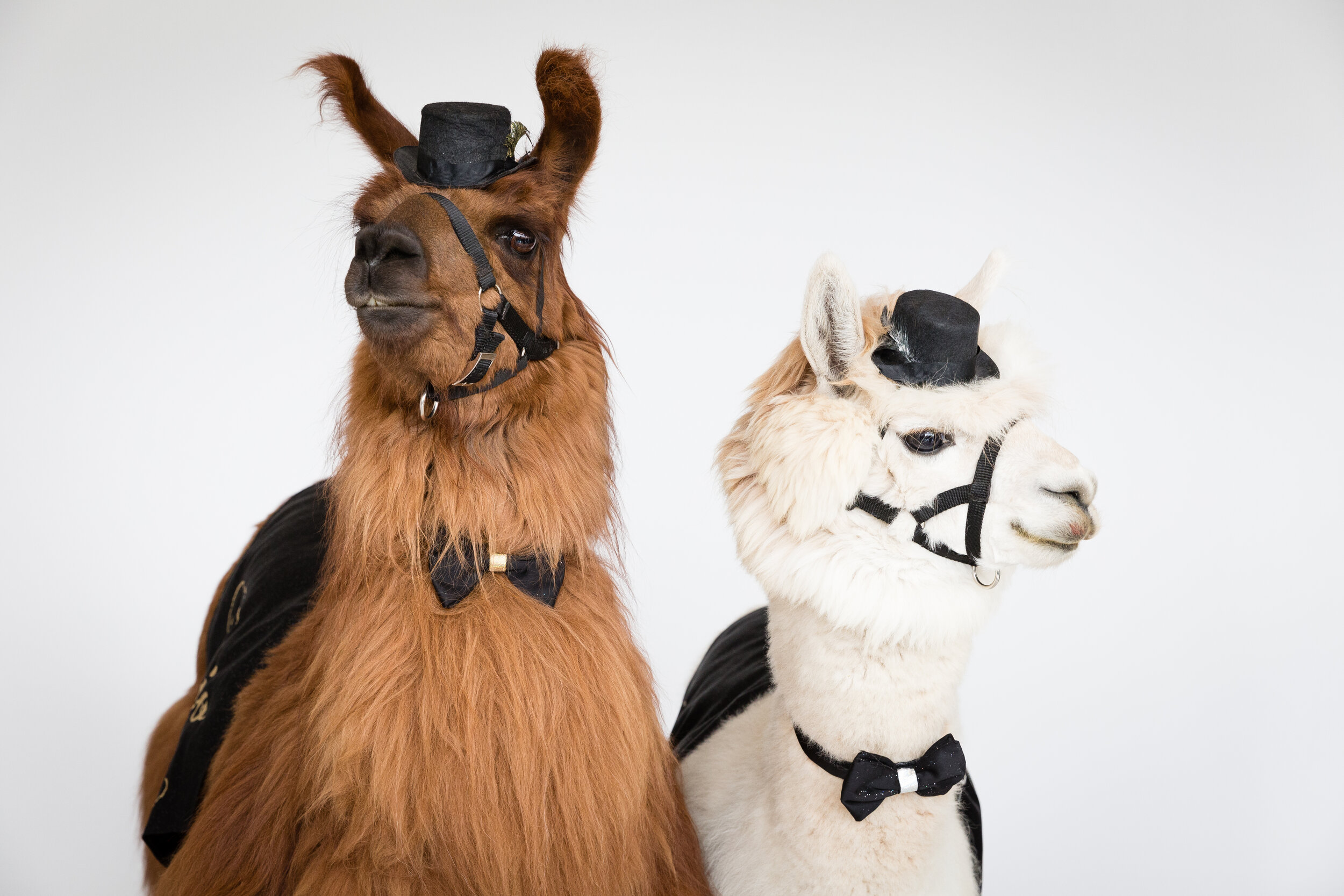Even more curious about these gentle giants?! Well here is a fun list of facts to impress your friends with at your next social gathering:
Llamas vs. Alpacas: What’s the difference?!
Rojo the LLAMA (left) & Napoleon the ALPACA (right)
First, look at their ears. Llamas have llong, banana-shaped ears where alpacas have short, spear-shaped ears resembling an “A.” See what I did there- llong, llama; A, Alpaca. Now you’ll never forget!
Napoleon the Alpaca (right)
Alpacas are about half the size of llamas but produce three times more fiber (alpaca & llama hair is called fiber) on their body. This means most alpaca farmers use alpacas for their super fine and luxurious coats similar to sheep wool (but llama/alpaca fiber is hypoallergenic!). Due to the density of their fiber, it is very important to shear alpacas once a year all over their body giving them a more goofy appearance for the summer.
Panda the LLAMA (left)
Llamas have llong, silky fiber that doesn’t need to be shorn all over to stay cool. This is where their owners have fun with the flexibility of how to shear their llamas before each summer. Most llamas are very comfortable with just their midsection shorn as that is where the bulk of their body heat leaves them.
Llamas are naturally more independent animals. They have a keen sense of protection over their herd making them fantastic guard animals. Put one llama, typically a female, in with your herd of alpacas, sheep, or goats, and they will protect them from coyotes and even mountain lions. I’ve even heard of a few of them chasing away a bear! I’d imagine not many predators are used to their +300lb prey running right towards them. Being larger in size, llamas can carry around 1/3 of their weight.
The Camelid Family
Want even more facts? Here’s a whole list supplied by tipsavvy.com. **Not an affiliate. Sometimes copy & paste is so much easier.
Camelids first appeared on the Central Plains of North America before the llamas’ ancestors migrated to South America.
Llamas were first domesticated and used as pack animals 4,000 to 5,000 years ago by Indians in the Peruvian highlands.
Llamas can grow as much as 6 feet tall.
Llamas weigh 280 to 450 pounds and can carry about a quarter of their body weight, so a 400-pound male llama can carry about 100 pounds on a trek of 10 to 12 miles with no problem.
Here’s a fun fact: Llamas know their own limits. If you try to overload a llama with too much weight, the llama is likely to lie down or simply refuse to move. *TRUTH
In the Andes Mountains of Peru, llama fleece has been shorn and used in textiles for about 6,000 years. Llama wool is light, warm and water-repellent.
Llamas are hardy and well suited to harsh environments.
Llamas are smart and easy to train.
Llamas are vegetarians and have efficient digestive systems.
Here’s a weird fact for you: A llama’s stomach has three compartments similar to a cow’s who has four.
Here’s a fun, believe it or not fact: Llama poop has almost no odor. Llama farmers refer to llama manure as “llama beans.” It makes great, eco-friendly fertilizer. The Incas in Peru burned dried llama poop for fuel. *This is why no one ever noticed if Rojo or Napoleon use their “diapers” while out in the public.
Llamas live to be about 20-30 years old.
A baby llama is called a “cria.” It’s pronounced KREE-uh. Mama llamas usually only have one baby at a time. Llama twins are incredibly rare. Pregnancy lasts for about 350 days—nearly a full year. Crias weigh 20 to 35 pounds at birth. *Camelids also begin ovulation when introduced to a male. Super fun fact!
Llamas come in a range of solid and spotted colors including black, gray, beige, brown, red and white *more than 52 natural colors as classified in Peru, 12 as classified in Australia and 16 as classified in the United States as stated by wikipedia.org/wiki/alpaca
Llamas are social animals and prefer to live with other llamas or herd animals
A group of llamas is called a herd.
Llamas have two wild “cousins” that have never been domesticated: the vicuña and the guanaco.
Llamas don’t bite. They spit when they’re agitated, but that’s mostly at each other. *You can easily train a camelid to not spit by spraying them with water, “spitting” at them first and creating a dominance as their owner/trainer
The current population of llamas and alpacas in South America is estimated to be more than 7 million, and there are about 158,000 llamas and 100,000 alpacas in the U.S. and Canada today.
Yarn made from llama fiber is soft and lightweight, yet remarkably warm.
AND NOW YOU KNOW
*These facts are added by Shannon for your enjoyment.



